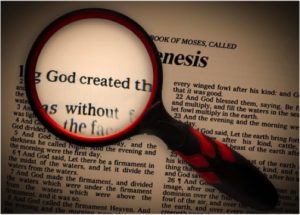 If you made it to this page, that means you have an interest in digging deeper into what we’ve been studying in our Sunday school class. Welcome!
If you made it to this page, that means you have an interest in digging deeper into what we’ve been studying in our Sunday school class. Welcome!
Posted below in “Class Materials” are some of the documents used in our lessons, such as the Glossary of terms, Views of the Creation Days, and others. Some websites that relate to the topics we discussed are also linked with a brief description of what you can find there. Immediately below is an Announcement section where I will periodically update what we will be studying, and tell you about some special events.
Announcements
See the church’s webpage for the address and directions to the church.
Young Earth Creation
 Ken Ham founded Answers in Genesis (AiG) in 1994 and is its president. AiG describes itself as follows: “Answers in Genesis is an apologetics (i.e., Christianity-defending) ministry, dedicated to enabling Christians to defend their faith and to proclaim the gospel of Jesus Christ effectively.” It holds to a young earth creation understanding of Genesis 1, believing the earth was created in six 24-hour days around 6,000 years ago. It also affirms there was a global flood, believing that what is at stake, if you reject it, is the authority of God’s Word. AiG also owns and operates the Creation Museum (opened in May of 2007) and the Ark Encounter (opened in July of 2016). Links to these sites are on the AiG site.
Ken Ham founded Answers in Genesis (AiG) in 1994 and is its president. AiG describes itself as follows: “Answers in Genesis is an apologetics (i.e., Christianity-defending) ministry, dedicated to enabling Christians to defend their faith and to proclaim the gospel of Jesus Christ effectively.” It holds to a young earth creation understanding of Genesis 1, believing the earth was created in six 24-hour days around 6,000 years ago. It also affirms there was a global flood, believing that what is at stake, if you reject it, is the authority of God’s Word. AiG also owns and operates the Creation Museum (opened in May of 2007) and the Ark Encounter (opened in July of 2016). Links to these sites are on the AiG site.
 The Institute for Creation Research (ICR) was founded by Dr. Henry Morris in 1970. It exists “to conduct scientific research within the realms of origins and earth history.” The coauthor of The Genesis Flood, Henry Morris is considered by many to be the “father of modern creation science.” ICR also affirms a young earth creation understanding of Genesis 1 and a global flood.
The Institute for Creation Research (ICR) was founded by Dr. Henry Morris in 1970. It exists “to conduct scientific research within the realms of origins and earth history.” The coauthor of The Genesis Flood, Henry Morris is considered by many to be the “father of modern creation science.” ICR also affirms a young earth creation understanding of Genesis 1 and a global flood.
Progressive Creation
 Intelligent Design Theory (intelligentdesign.org) “holds that certain features of the universe and of living things are best explained by an intelligent cause, not an undirected process such as natural selection.” It formally states that it opposes “neo-Darwinism,” but not evolutionary theory per say. It also claims that ID Theory is not based on the Bible: “The idea that human beings can observe signs of intelligent design in nature reaches back to the foundations of both science and civilization.” There are links on the website to other ID Theory sites.
Intelligent Design Theory (intelligentdesign.org) “holds that certain features of the universe and of living things are best explained by an intelligent cause, not an undirected process such as natural selection.” It formally states that it opposes “neo-Darwinism,” but not evolutionary theory per say. It also claims that ID Theory is not based on the Bible: “The idea that human beings can observe signs of intelligent design in nature reaches back to the foundations of both science and civilization.” There are links on the website to other ID Theory sites.
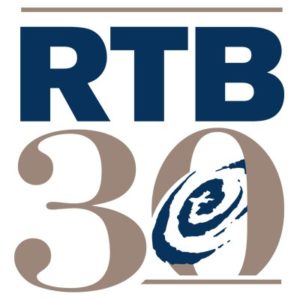 Reasons to Believe (RTB) holds that: “Sound reason and scientific research—including the very latest discoveries—consistently support, rather than erode, confidence in the truth of the Bible and faith in the personal, transcendent God revealed in both Scripture and nature.” It was founded in 1986 by Hugh Ross, an astrophysicist. Their Creation Model Approach is a testable model approach to integrating science and the Christian faith. RTB holds to a day-age understanding of the creation days of Genesis 1, where creation occurred over billions of years, corresponding to the geological time-scale. These “ages” happened in the same sequence as the days in Genesis 1.
Reasons to Believe (RTB) holds that: “Sound reason and scientific research—including the very latest discoveries—consistently support, rather than erode, confidence in the truth of the Bible and faith in the personal, transcendent God revealed in both Scripture and nature.” It was founded in 1986 by Hugh Ross, an astrophysicist. Their Creation Model Approach is a testable model approach to integrating science and the Christian faith. RTB holds to a day-age understanding of the creation days of Genesis 1, where creation occurred over billions of years, corresponding to the geological time-scale. These “ages” happened in the same sequence as the days in Genesis 1.
Evolutionary Creation
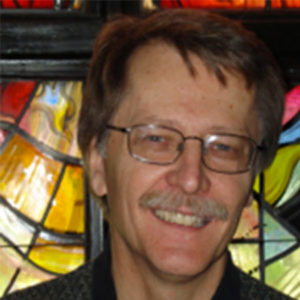 Denis Lamoureux’s material appears at various times in this study. The class discussion on evolutionary creation is taken from his book, I Love Jesus & I Accept Evolution. He is an Associate Professor of Science and Religion at St. Joseph’s College in the University of Alberta. His academic specialty focuses on the modern origins controversy. You can go to his webpage here. Click on the link for Web Lectures for a series of talks on several different topics., including “Beyond the ‘Evolution’ and ‘Creation’ Debate.” Part 5 is reviewed in class and we use part of his handout for that class. If you are interested in a more detailed discussion of this issue, watch the various lectures. Part 3, “Views on the Origin of Universe & Life,” will give you a more detailed discussion of the handout we looked at. If you’re interested in how he came to Christ and went from a vehement young earth creationist to an evolutionary creationist, listen to “My Personal Story.”
Denis Lamoureux’s material appears at various times in this study. The class discussion on evolutionary creation is taken from his book, I Love Jesus & I Accept Evolution. He is an Associate Professor of Science and Religion at St. Joseph’s College in the University of Alberta. His academic specialty focuses on the modern origins controversy. You can go to his webpage here. Click on the link for Web Lectures for a series of talks on several different topics., including “Beyond the ‘Evolution’ and ‘Creation’ Debate.” Part 5 is reviewed in class and we use part of his handout for that class. If you are interested in a more detailed discussion of this issue, watch the various lectures. Part 3, “Views on the Origin of Universe & Life,” will give you a more detailed discussion of the handout we looked at. If you’re interested in how he came to Christ and went from a vehement young earth creationist to an evolutionary creationist, listen to “My Personal Story.”
Here is a link to a 14 minute “TED” Talk that Denis Lamoureux gave on his web lecture noted above, “Beyond the ‘Evolution’ and ‘Creation’ Debate.” He is giving it to a secular audience, so there are some differences in what he presents in his web lecture of the same name. Part 3, “Views on the Origin of Universe & Life,” from his web lecture in not discussed or referred to at all. Still, a worthwhile view and you get to see and hear him, eh?
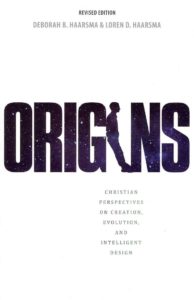 Loren and Deborah Haarsma are the authors of the book, Origins. Loren is a professor in the physics and astronomy department at Calvin College. Deborah was a professor in the same department, but since January of 2013 she has been the president of BioLogos. You can follow this link to the Origins webpage for Faith Alive Resources, the publisher of Origins. The Haarsmas have placed six video sessions on topics from their book under “watch online.” We watch some of the videos in class. They have also provided short articles that expand on topics in their book and a few charts from the ebook of Origins.
Loren and Deborah Haarsma are the authors of the book, Origins. Loren is a professor in the physics and astronomy department at Calvin College. Deborah was a professor in the same department, but since January of 2013 she has been the president of BioLogos. You can follow this link to the Origins webpage for Faith Alive Resources, the publisher of Origins. The Haarsmas have placed six video sessions on topics from their book under “watch online.” We watch some of the videos in class. They have also provided short articles that expand on topics in their book and a few charts from the ebook of Origins.
 BioLogos was founded by Francis Collins, the author of The Language of God. Dr. Collins was the director of the Human Genome Project and currently serves as the Director of the National Institutes of Health. Deborah Haarsma, co-author of Origins is the current President of Biologos. The core commitments of BioLogos are: “We embrace the historical Christian faith, upholding the authority and inspiration of the Bible. We affirm evolutionary creation, recognizing God as Creator of all life over billions of years. We seek truth, ever learning as we study the natural world and the Bible. We strive for humility and gracious dialogue with those who hold other views. We aim for excellence in all areas, from science to education to business practices.” There is a wealth of information available on their website, including articles and videos on a variety of topics, including Age of the Earth, Fossil Record, Adam and Eve, Human Origins and Christianity and Science. John Walton, whose views on Genesis 1 and Adam and Eve are covered in our Sunday school class, has several articles and some videos. Do a search for “John Walton” and you’ll pull up all his material, including a 2 hour documentary that reviews his position on Genesis 1.
BioLogos was founded by Francis Collins, the author of The Language of God. Dr. Collins was the director of the Human Genome Project and currently serves as the Director of the National Institutes of Health. Deborah Haarsma, co-author of Origins is the current President of Biologos. The core commitments of BioLogos are: “We embrace the historical Christian faith, upholding the authority and inspiration of the Bible. We affirm evolutionary creation, recognizing God as Creator of all life over billions of years. We seek truth, ever learning as we study the natural world and the Bible. We strive for humility and gracious dialogue with those who hold other views. We aim for excellence in all areas, from science to education to business practices.” There is a wealth of information available on their website, including articles and videos on a variety of topics, including Age of the Earth, Fossil Record, Adam and Eve, Human Origins and Christianity and Science. John Walton, whose views on Genesis 1 and Adam and Eve are covered in our Sunday school class, has several articles and some videos. Do a search for “John Walton” and you’ll pull up all his material, including a 2 hour documentary that reviews his position on Genesis 1.
Additional Resources
 Vern Poythress is a Professor of New Testament Interpretation at Westminster Theological Seminary in Philadelphia. He also serves as the Editor of the Westminster Theological Journal. At frame-poythress.org you will find “resources from the pens of John Frame and Vern Poythress, two Reformed theologians who have made contributions to the body of Christ in systematics, epistemology, linguistics, sociology, and other fields.” Under the “ebooks” link on the website are electronic files of many of their published works available for personal use for free! Three of the works I used for this class by Poythress are there, Redeeming Science, Did Adam Exist?, and Christian Interpretations of Genesis 1. But don’t stop there. Take some time to look at what else is available. Several of the books that shaped my personal theological and biblical worldview are there.
Vern Poythress is a Professor of New Testament Interpretation at Westminster Theological Seminary in Philadelphia. He also serves as the Editor of the Westminster Theological Journal. At frame-poythress.org you will find “resources from the pens of John Frame and Vern Poythress, two Reformed theologians who have made contributions to the body of Christ in systematics, epistemology, linguistics, sociology, and other fields.” Under the “ebooks” link on the website are electronic files of many of their published works available for personal use for free! Three of the works I used for this class by Poythress are there, Redeeming Science, Did Adam Exist?, and Christian Interpretations of Genesis 1. But don’t stop there. Take some time to look at what else is available. Several of the books that shaped my personal theological and biblical worldview are there.
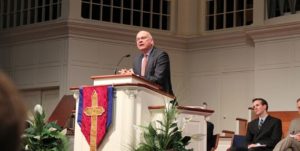 Tim Keller wrote, “Creation, Evolution, and Christian Laypeople,” to address this controversy over creation and evolution. He pointed out that “the voices arguing that Biblical orthodoxy and evolution are mutually exclusive are louder and more prominent than any others.” He pointed out that New Atheist writers such as Richard Dawkins and creationists like Ken Ham agree that you can’t believe in God and believe in evolution. Keller concluded that: “Christians who are seeking to correlate Scripture and science must be a ‘bigger tent’ than either the anti-scientific religionists or the anti-religious scientists.”
Tim Keller wrote, “Creation, Evolution, and Christian Laypeople,” to address this controversy over creation and evolution. He pointed out that “the voices arguing that Biblical orthodoxy and evolution are mutually exclusive are louder and more prominent than any others.” He pointed out that New Atheist writers such as Richard Dawkins and creationists like Ken Ham agree that you can’t believe in God and believe in evolution. Keller concluded that: “Christians who are seeking to correlate Scripture and science must be a ‘bigger tent’ than either the anti-scientific religionists or the anti-religious scientists.”
 Genesis and the Flood is a series of blog articles on BioLogos written by Tremper Longman that seeks to reconcile the biblical message of the Flood with the findings of modern science. Dr. Longman has been a professor at Westmont College in California for over twenty years. Before that he was a professor at Westminster Theological Seminary. In his series, he seeks “to raise questions about the proper interpretation of the story of the Flood.”
Genesis and the Flood is a series of blog articles on BioLogos written by Tremper Longman that seeks to reconcile the biblical message of the Flood with the findings of modern science. Dr. Longman has been a professor at Westmont College in California for over twenty years. Before that he was a professor at Westminster Theological Seminary. In his series, he seeks “to raise questions about the proper interpretation of the story of the Flood.”
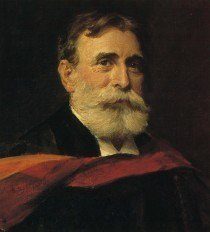 B. B. Warfield wrote two essays that offer the fullest account of his sense of how to best harmonize a Christian understanding of creation and evolution. “Creation, Evolution, and Mediate Creation” is here in its entirety. The first section of “The Manner and Time of Man’s Origin,” articulates his thoughts on the manner of human creation as a product of divinely superintended evolutionary processes (within the sense defined in “Creation, Evolution, and Mediate Creation”). The excluded section of “The Manner and Time of Man’s Origin” was written to convince Christians that the bible does not demand an earth only six thousand years old. The original essay by his colleague William Henry Green, upon which Warfield based his biblical evidence to reject a six thousand year old earth, is available in a separate link. This material is for personal use only. It was orginally in Evolution, Science, and Scripture: Selected Writings by Warfield; edited by Mark Noll and David Livingston.
B. B. Warfield wrote two essays that offer the fullest account of his sense of how to best harmonize a Christian understanding of creation and evolution. “Creation, Evolution, and Mediate Creation” is here in its entirety. The first section of “The Manner and Time of Man’s Origin,” articulates his thoughts on the manner of human creation as a product of divinely superintended evolutionary processes (within the sense defined in “Creation, Evolution, and Mediate Creation”). The excluded section of “The Manner and Time of Man’s Origin” was written to convince Christians that the bible does not demand an earth only six thousand years old. The original essay by his colleague William Henry Green, upon which Warfield based his biblical evidence to reject a six thousand year old earth, is available in a separate link. This material is for personal use only. It was orginally in Evolution, Science, and Scripture: Selected Writings by Warfield; edited by Mark Noll and David Livingston.
William Henry Green, an Old Testament professor at Princeton Theological Seminary in the late 1800s, addressed the question of the age of the earth in his 1890 article in the journal Bibliotheca Sacra, “Primeval Chronology.” Green said the accepted chronology of his time (Ussher’s chronology) was based upon an assumption that there were no gaps in the biblical genealogies, most notably those of Genesis 5 and 11. However, when he examined the biblical genealogies he found: “There is an element of uncertainty in a computation of time which rests upon genealogies, as the sacred chronology so largely does.”
The American Scientific Affiliation was founded in 1941 as an international network of Christians in the sciences. It is not an advocacy group for a position on science or religion. “Where there is honest disagreement on an aspect of science, Christian faith, or the relationship between the two, the ASA strives to create a safe environment in which dialogue can flourish and diverse, even contrasting, ideas can be discussed with courtesy and respect.” There is a plethora (yes, plethora) of information there under their resources link. Here is a link to a series of articles about the history of the American Scientific Society on BioLogos.
The Anthropic-Principle: More than two-dozen parameters of the universe must have values falling within narrowly defined ranges for life of any kind to exist. Here is a sampling of some of those parameters.
Here is a link to an article written by Dr. Richard H. Bube. He is Emeritus Professor of Materials Science and Electrical Engineering at Stanford University. “We Believe in Creation” was published in 1971 and helped the American Scientific Affiliation move away from the “creation-evolution” dichotomy. For many years at Stanford Bube taught a seminar on Christianity and science.
“Summarizing the Biblical-Theological Case for Eden Being a Temple-Garden” is a short blog post on the Reformed Forum that summarizes twelve arguments supporting the belief that Eden was a temple-garden.
“Were Adam and Eve historical figures?” is a BioLogos summary of three possible views on understanding Adam and Eve. Did you know that Billy Graham and Tim Keller were both open to models of evolution that are compatible with Adam and Eve as real historical people? Give a listen to the short video by Alister McGrath on his non-historical view.
Class Materials
Biblical Evidence of Randomness: This is a selection of biblical passages illustrating how God sovereignly worked through what seemed to be random events from a human perspective.
This is a Glossary of terms relevant to our Genesis & Creation study.
Relationship of Science: This page duplicates the Creator-Creation graphic and the graphics showing the relationship of science and religion, nature and Scripture.
This handout, Lamoureux Origins, is a copy of the handout Denis Lamoureux uses for his web lecture, “Beyond the ‘Evolution’ and ‘Creation’ Debate.” The second page, Views on the Origin of the Universe & Life, is one of the Sunday School class handouts. There are also other graphics in the handout that appear in our lessons. The Lamoureux Origins handout is for personal use only and is used here with the permission of Denis Lamoureux.
Views of the Creation Days. This is the handout used in class with a brief overview of the various ways the creation days in Genesis 1 can be understood.
